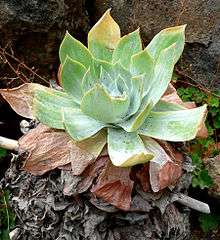Dudleya pulverulenta
Dudleya pulverulenta is a succulent plant known by the common names chalk lettuce, chalk dudleya, and chalk liveforever.
| Dudleya pulverulenta | |
|---|---|
 | |
| Scientific classification | |
| Kingdom: | Plantae |
| Clade: | Tracheophytes |
| Clade: | Angiosperms |
| Clade: | Eudicots |
| Order: | Saxifragales |
| Family: | Crassulaceae |
| Genus: | Dudleya |
| Species: | D. pulverulenta |
| Binomial name | |
| Dudleya pulverulenta | |
Distribution
This Dudleya is native to the southwestern United States and northern Mexico, where it is found in steep open rocky areas in coastal and inland mountains and desert foothills, such as the Santa Monica Mountains.
Description
Dudleya pulverulenta grows a rosette of wide, flat fleshy leaves of pale green which age to a pinkish papery texture. It produces one to many tall erect stems which are similar in color. The epidermis of the plant is covered with a dense coating of chalky, powdery "wax". Its pale green or white nodding or erect inflorescences bear many pinkish flowers, each on a long pedicel.[1]
Dudleya pulverulenta is similar in appearance to Dudleya brittonii.
Habitat
The plant tolerates full sun exposure or part shade. It is susceptible to aphid infestations which result in flower and rosette deformities. Openly hybridizes with several other species. Plant appears to have very good cold tolerance when mature and has survive temperatures of 18 degrees F in a local garden with no ill effects. Higher temperatures are also tolerated well by Dudleya with the white chalky and mealy "wax" coatings, which reflect light and prevent evaporation.
Plants are very rapid recolonizers as evidenced by proliferation on roadcuts shortly after development. It is a much hardier plant for the garden environment than the more commonly available Dudleya brittoni.
Unusual "wax" coating
Leaves grow in a basal rosette and are covered with a dusty, chalky, mealy white epicuticular "wax", as are the flower stalk and flowers. Although wax is usually categorized as a hydrophobic substance, this plant’s epicuticular wax (waxy leaf coating on the surface of leaves), when drops of water land on the Dudleya pulverulenta leaves, the "wax" is attracted to the water droplets, and rises and coats the drops on the leaves, increasing the apparent surface tension of the droplets so that they are much larger than uncoated drops of water, and then it prevents evaporation of the coated drops. When the drops dry, the evaporate is thin and smooth and no longer mealy. "Wax" that has washed off the leaves also coats the ground around the base of the plant, further preventing evaporation.
References
- Dudleya and Hassenthaus Handbook, Paul Thompson 1993